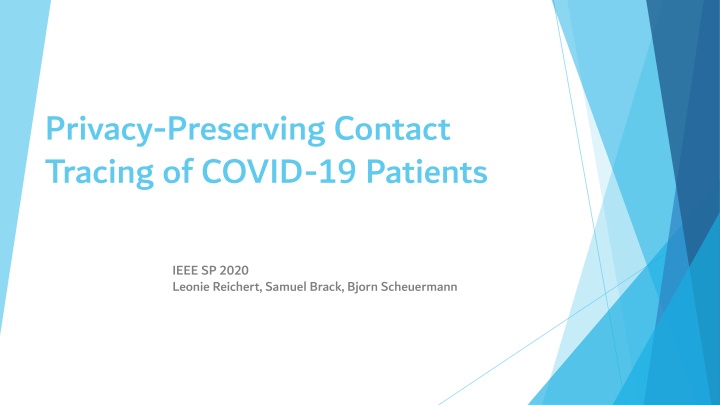
Privacy-Preserving Contact Tracing of COVID-19 Patients
Learn about the innovative privacy-preserving contact tracing methods developed for COVID-19 patients in a research paper presented at IEEE SP 2020. The paper explores the use of digital solutions like Bluetooth and GPS to automate contact tracing, addressing privacy concerns experienced by various countries. Discover how countries like South Korea, Israel, Germany, and Italy have dealt with the privacy problem while developing effective contact tracing solutions.
Download Presentation

Please find below an Image/Link to download the presentation.
The content on the website is provided AS IS for your information and personal use only. It may not be sold, licensed, or shared on other websites without obtaining consent from the author. If you encounter any issues during the download, it is possible that the publisher has removed the file from their server.
You are allowed to download the files provided on this website for personal or commercial use, subject to the condition that they are used lawfully. All files are the property of their respective owners.
The content on the website is provided AS IS for your information and personal use only. It may not be sold, licensed, or shared on other websites without obtaining consent from the author.
E N D
Presentation Transcript
Privacy-Preserving Contact Tracing of COVID-19 Patients IEEE SP 2020 Leonie Reichert, Samuel Brack, Bjorn Scheuermann
Outline Introduction Related Work System Design Conclusion
Introduction - Background COVID-19 pandemic shows the necessity to automate contact tracing. Contact tracing deals with finding unreported infected people.
Introduction - Contact Tracing Two main purposes: 1. Global level: Helps medical personnel to trace the pattern of virus spreading and take appropriate actions 2. Individual level: Helps the medical personnel to alert individuals who might have been infected.
Introduction - Contact Tracing Solutions 1. Manually contact tracing 2. Digital contack tracing a. Bluetooth b. GPS
Introductionn - Privacy Problem 1. South Korea gives out detailed information about patient 2. Israel passed new laws to spy on its citizens 3. Germany is modeling how people are moving around 4. Italy has created movement maps
Outline Introduction Related Work System Design Conclusion
Related Work - Singapore(trace together) First automatic contact tracing TraceTogether allows you to be informed if you were in prolonged physical proximity with an infected person. It exchanges encrypted and Bluetooth signals with nearby TraceTogether devices.
Related Work - COVIDSafe app The COVIDSafe app helps state and territory health officials to quickly identify and contact people who may have been exposed to COVID-19 (called close contacts ). Being able to recall everyone they have been in close contact with Knowing their contact details
Outline Introduction Related Work System Design Conclusion
System Design Secure Multi-party Computation (MPC) Oblivious Random Access Memory Contact Tracing Algorithm
Contact Tracing with Secure Multiparty Computation Health authorities (HA) collecting location histories of infected users Individuals use location-based services that store their history locally Each individual has to perform oblivious communication with the HA. Contact tracing is done in private so that only the traced individual can learn their status.
System Design X Oblivious Random Access Memory (ORAM) Secure Multi-party Computation (MPC)
Secure Multi-party Computation Each person does not want to reveal their individual information to each other or a trusted third-party during the computation. Secure multiparty computation (MPC / SMPC) is a cryptographic protocol that distributes a computation across multiple parties where no individual party can see the other parties data.
Secure Multi-party Computation User A 1 2 3 4 5 6 7 User B
Secure Multi-party Computation A group of p independent participants to collectively evaluate a function y1, , yn = f(x1, , xp). x2 MPC y2 F(x)
Secure Multi-party Computation An infected person shares her location data with the health authority. Three untested individuals start separate MPC sessions with the HA. Note that not every positively evaluated contact is necessarily infected.
Oblivious Random Access Memory The oblivious database can either be located on a single server participating in the MPC execution or shared between all parties in the form of secret shares.
Oblivious Random Access Memory To hide reading or records. ORAM mixes memory, from time to time, so the opponent sees only the got access to physical memory, and can't know whether you addressed the same data twice or two different data. A data B data C data D data
Contact Tracing Algorithm Input locations l := (x, y, t) consist of geographical coordinates and a temporal component. Each user u has m to-be-checked locations in their location history. The HA holds a number of n location data points from infected individuals.
Contact Tracing Algorithm For a location l each component is rounded to a fixed granularity, so that it can be represented by one position on the grid. A set of locations L are calculated for which the Euclidean distance to l is smaller than a fixed threshold. A data point l is rounded to the closest position on the grid. The set L of adjacent grid locations is computed covering the region close to l.
Outline Introduction Related Work System Design Conclusion
Conclusion Our proposed system uses a central party (the HA) for contact tracing. Each person wishing to check their own history for contact points with infected people has to go through this central instance no sensitive user data is leaked to other users or the HA.
